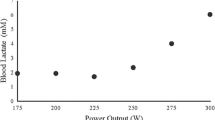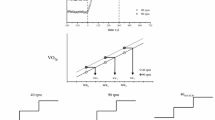Summary
The purpose of this study was to examine whether the ventilatory threshold (Th v) would give the maximal lactate steady state ([1a]ss, max), which was defined as the highest work rate (W) attained by a subject without a progressive increase in blood lactate concentration [1a]b at constant intensity exercise. Firstly, 8 healthy men repeated ramp-work tests (20 W·min−1) on an electrically braked cycle ergometer on different days. During the tests, alveolar gas exchange was measured breath-by-breath, and theW atTh v (W Th v) was determined. The results of two-way ANOVA showed that the coefficient of variation of a singleW Th v determination was 2.6%. Secondly, 13 men performed 30-min exercise atW Th v (Th v trial) and at 4.9% aboveW Th v (Th v + trial), which corresponded to the 95% confidence interval of the single determination. The [1a]b was measured at 15 and 30 min from the onset of exercise. The [1a]b at 15 min (3.15 mmol·1−1, SEM 0.14) and at 30 min (2.95 mmol·1−1, SEM 0.18) were not significantly different inTh v trial. However, the [1a]b ofTh v+ trial significantly increased (P<0.05) from 15 min (3.62 mmol·1−1, SEM 0.36) to 30 min (3.91 mmol·1−1, SEM 0.40). These results indicate thatTh v gives the [1a]ss,max, at which one can perform sustained exercise without continuous [1a]b accumulation.
Similar content being viewed by others
References
Allen WK, Seals DR, Hurley BF, Ehsani AA, Hagberg JM (1985) Lactate threshold and distance-running performance in young and older endurance athletes. J Appl Physiol 58:1281–1284
Beaver WL, Wasserman K, Whipp BJ (1986) A new method for detecting anaerobic threshold by gas exchange. J Appl Physiol 60:2020–2027
Caiozzo VJ, Davis JA, Ellis JF, Azus JL, Vandagriff R, Prietto CA, McMaster WC (1982) A comparison of gas exchange indices used to detect the anaerobic threshold. J Appl Physiol Respir Environ Exerc Physiol 53:1184–1189
Coyle EF, Martin WH, Ehsani AA, Hagberg JM, Bloomfield SA, Sinacore DR, Holloszy JO (1983) Blood lactate threshold in some well-trained ischemic heart disease patients. J Appl Physiol Respir Environ Exerc Physiol 54:18–23
Davis JA, Frank MH, Whipp BJ, Wasserman K (1979) Anaerobic threshold alterations caused by endurance training in middle-aged men. J Appl Physiol Respir Environ Exerc Physiol 46:1039–1046
Gaesser GA, Poole DC (1986) Lactate and ventilatory threshold: disparity in time course of adaptation to training. J Appl Physiol 61:999–1004
Green HJ, Hughson RL, Orr GW, Ranney DA (1983) Anaerobic threshold, blood lactate, and muscle metabolites in progressive exercise. J Appl Physiol Respir Environ Exerc Physiol 54:1032–1038
Hagberg JM (1984) Physiological implication of the lactate threshold. Int J Sports Med 5:106–109
Heck H, Mader A, Hess G, Mucke S, Muller R, Hollmann W (1985) Justification of the 4 mmol·1-−1 lactate threshold. Int J Sports Med 6:117–130
Hughes EF, Turner SC, Brooks GA (1982) Effects of glycogen depletion and pedalling speed on “anaerobic threshold”. J Appl Physiol Respir Environ Exerc Physiol 52:1598–1607
Hughson RL (1984) Methodololgies for measurement of the anaerobic threshold. Physiologist 27:304–311
Hughson RL, Green HJ (1982) Blood acid-base and lactate relationship studied by ramp work tests. Med Sci Sports Exerc 14:297–302
Hughson IL, Inman MD (1986) Oxygen uptake kinetics from ramp work tests: variability of single test values. J Appl Physiol 61:373–376
Hughson RL, Weisinger KH, Swanson GD (1987) Blood lactate concentration increases as a continuous function in progressive exercise. J Appl Physiol 62:1975–1981
Ivy JL, Withers RT, Van Handel PJ, Elger DH, Costill DL (1980) Muscle respiratory capacity and fiber type as determinants of the lactate threshold. J Appl Physiol Respir Environ Exerc Physiol 48:523–527
Kinderman W, Simon G, Kuel J (1979) The significance of the aerobic-anaerobic transition for the determination of work load intensities during endurance training. Eur J Appl Physiol 42:25–34
Mader A, Heck H (1986) A theory of the metabolic origin of anaerobic threshold. Int J Sports Med 7:45–65
Naimark A, Wasserman K, McIlroy MB (1964) Continuous measurement of ventilatory exchange ratio during exercise. J Appl Physiol 19:644–652
Poole DC, Gaesser GA (1985) Response of ventilatory and lactate thresholds to continuous and interval training. J Appl Physiol 58:1115–1121
Prud'homme D, Bouchard C, Leblance C, Landry F, Lortie G, Boulay MR (1984) Reliability of assessments of ventilatory thresholds. J Sports Sci 2:13–24
Reybrouck T, Ghesquiere J, Cattaert A, Fagard R, Amery A (1983) Ventilatory threshold during short- and long-term exercise. J Appl Physiol Respir Environ Exerc Physiol 55:1694–1700
Scheen A, Juchmes J, Cession-Fossion A (1981) Critical analysis of the “anaerobic threshold” during exercise at constant workloads. Eur J Appl Physiol 46:367–377
Sjodin B, Jacobs I (1981) Onset of blood lactate accumulation and marathon running performance. Int J Sports Med 2:23–26
Stegmann H, Kindermann W (1982) Comparison of prolonged exercise tests at the individual anaerobic threshold and the fixed anaerobic threshold of 4 mmol·1−1. Int J Sports Med 3:105–110
Stegmann H, Kindermann W, Schnabel A (1981) Lactate kinetics and individual anaerobic threshold. Int J Sports Med 2:160–165
Wasserman K, McIlroy MB (1964) Detecting the threshold of anaerobic metabolism in cardiac patients during exercise. Am J Cardiol 14:844–852
Wasserman K, Whipp BJ, Koyal SN, Beaver WL (1973) Anaerobic threshold and respiratory gas exchange during exercise. J Appl Physiol 35:236–243
Wasserman K, Hansen JE, Sue DY, Whipp BJ (1986) Principles of exercise testing and interpretation. Lea and Febiger, Philadelphia
Whipp BJ, Davis JA, Torres F, Wasserman K (1981) A test to determine parameters of aerobic function during exercise. J Appl Physiol Respir Environ Exerc Physiol 50:217–221
Yamamoto Y, Takei Y, Mokushi K, Morita H, Mutoh Y, Miyashita M (1987) Breath-by-breath measurement of alveolar gas exchange with a slow-Reponse gas analyser. Med Biol Eng Comput 25:141–146
Author information
Authors and Affiliations
Rights and permissions
About this article
Cite this article
Yamamoto, Y., Miyashita, M., Hughson, R.L. et al. The ventilatory threshold gives maximal lactate steady state. Europ. J. Appl. Physiol. 63, 55–59 (1991). https://doi.org/10.1007/BF00760802
Accepted:
Issue Date:
DOI: https://doi.org/10.1007/BF00760802




